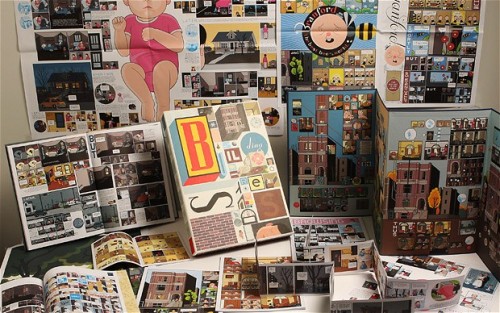One way of defining the genius of Chris Ware is to say that he fuses the disparate forms of comics and architecture, using his nonpareil skills in visual storytelling to show how the buildings we construct are not just empty containers but influence us as much as we shape them. JEET HEER reviews Chris Ware’s masterpiece.
When is a book like a building? When Chris Ware is the author
The printed book, we are constantly told, is becoming obsolete in the face of online competition. Perhaps so, but Ware is a partisan of tangibility, the tactile world of objects that you can touch, including books and buildings. Although a small snippet of Building Stories originally appeared online, the total object that Ware has now created could exist only in our three-dimensional world. In telling his stories through beautiful printed objects, he is making as strong case for the continued centrality of the book as a form even in an age of easy access to digital “content.” Form and content in Ware’s work are never severed but always imaginatively working together, like two partners in a stunning dance number.
But to praise Ware simply for his art or formal inventiveness is to short shrift the power of his storytelling. There are several characters in Building Stories: One is a century-old Chicago apartment wistfully remembering better days; another is the aged landlady who owns the structure, and another is a bee that gets temporarily trapped in a windowsill. But the central character of the graphic novel is an unnamed young woman who lives in the top floor of the building.
38 notes
paranoiidandroid liked this
onechrisn reblogged this from pantheonbooks
theiconoclastkid liked this
gothicbot liked this
secreteggplantbaby reblogged this from lookingfromsolitude
unwordinglanguage-blog reblogged this from lookingfromsolitude
unwordinglanguage-blog liked this
jobertmcruz liked this
thedharmabeat liked this
goldenslumbr liked this
 gwendabond liked this
gwendabond liked this inbedwithbooks reblogged this from pantheonbooks and added:
This article is exactly what I need after people on ToB protesting that it’s not a book. (C'mon, you’re smart, literate...
octoberintime liked this
 hughbot liked this
hughbot liked this un liked this
alexnall liked this
irobots2 liked this
artbypatch liked this
jbk-blog liked this
cash-money-cartoons liked this
juanonhell liked this
cannotremember liked this
spx reblogged this from pantheonbooks and added:
One of my prize SPX-related experiences from last year… Not just getting a copy of Building Stories from the man...
mega-wad liked this
onbeton liked this
 deathbyhiccups liked this
deathbyhiccups liked this mdt liked this
chadshotyou liked this
pantheonbooks reblogged this from notesfromtheroughfront
lookingfromsolitude posted this

